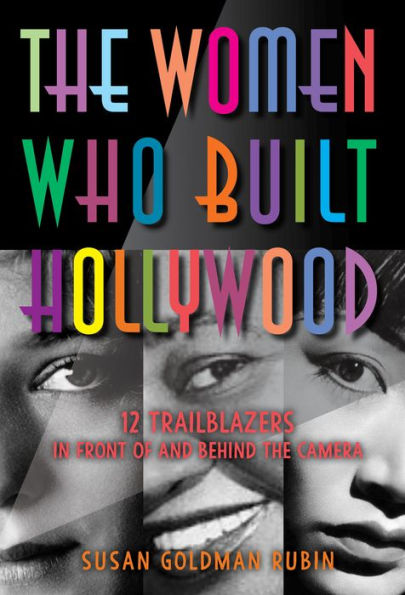
The Women Who Built Hollywood: 12 Trailblazers in Front of and Behind the Camera
208
The Women Who Built Hollywood: 12 Trailblazers in Front of and Behind the Camera
208Hardcover
-
PICK UP IN STORECheck Availability at Nearby Stores
Available within 2 business hours
Related collections and offers
Overview
While recent phenomena like #OscarsSoWhite have reminded us that Hollywood can be an unfriendly place to people of color and to women, they have been an integral part of the industry from the beginning. In the early twentieth century, women from all walks of life fought against sexism and racism to succeed in Hollywood as actors, directors, costume designers, editors, and stunt women. From well-known, glamorous starlets like Mary Pickford and Lillian Gish, to under-appreciated trailblazers like Anna May Wong and Hattie McDaniel, acclaimed author Susan Goldman Rubin shows that movies wouldn’t be the same without the women who succeeded against the odds and built Hollywood from the ground up. Filled with fascinating photographs and little-known facts, this rigorously researched book begins with a foreword by Ruth E Carter, who won Academy Awards in 2019 and 2023 for her work on Marvel Studios' Black Panther and Black Panther: Wakanda Forever.

Product Details
| ISBN-13: | 9781662680106 |
|---|---|
| Publisher: | Astra Publishing House |
| Publication date: | 05/16/2023 |
| Pages: | 208 |
| Sales rank: | 520,582 |
| Product dimensions: | 6.50(w) x 9.31(h) x 0.77(d) |
| Lexile: | 1060L (what's this?) |
| Age Range: | 12 - 17 Years |
About the Author
Read an Excerpt
Introduction
In the early days of Hollywood, an amazingly large number of female filmmakers existed. “The doors were wide open to women,” wrote a film historian. From 1900 till the 1920s, women not only acted in movies, but they also directed, produced, edited, wrote screenplays, designed costumes, performed stunts, and ran their own companies.
At that time, moviemaking wasn’t taken seriously as a business that would make money, so women grabbed opportunities to work in this new industry. They helped one another and kept the movie business thriving as films evolved from silents to talkies. Pioneering filmmakers experimented with modern equipment as they created entertainment for eager audiences.
Reportedly, the first motion picture camera had been invented by Thomas Edison in 1890, and people viewed his images through a peephole. Just a few years later, he promoted the Vitascope to project images on a screen, and audiences panicked as Sea Waves rushed toward them. In France, the Lumière brothers created the Cinématographe, and their film of a train hurtling out of the screen scared audiences who ducked and screamed. Filmmakers took to the idea of moving pictures and started telling stories.
The early silent movies called “flickers” were short one- and two-reelers. A single reel of film ran through a projector for eleven minutes and was displayed on a large screen. In America, the moving images appealed to millions of immigrants who couldn’t read or understand English. Connecting the written title cards with the movements of the actors helped them learn the language.
They enjoyed the stories of familiar neighborhood types— policemen, gangsters, and laundrywomen. Many more refined people detested the flickers because they considered the content crude. Stage actors looked down on moviemaking as “a complete disgrace,” a sure sign of failure for out-of-work performers who needed to earn some money. Compared to the theater, flickers seemed like a cheap form of entertainment. And it was. Nickelodeons were set up in empty storefronts filled with chairs. The name came from the price of admission, a nickel.
However, as short one- and two-reel films became longer features, screenings were moved from noisy nickelodeons to movie palaces. These luxurious “temples of the silent drama” were furnished with rugs, chandeliers, statues, and mirrors to attract middle-class white women who might bring their husbands to the movies for a nice night out worth the price of an expensive ticket. Ladies sipped tea in the women’s lounge. Uniformed ushers showed viewers to their plush seats. Female writers and directors created appealing stories.
With the invention of machinery that could record sound, a different style of movie appeared on the screen. Talkies began to replace silents in the late 1920s. The addition of sound transformed the look of movies. The art of the silent film was over. Companies grew larger and more competitive. The movie industry became big business headed by male executives and the studio system began. The “Big Five” studios—MGM, Paramount, Warner Brothers, Fox, and RKO— controlled every aspect of production in the 1930s and 1940s.
Yet ambitious women filmmakers pursued their careers during these changes as well as the epic events of the time: the women’s suffrage movement (1848–1920), the Chinese Exclusion Act (1882– 1943), the Jim Crow era (1890s 1964), World War I (1914–1918), the Spanish flu pandemic (1918–1920), and the Great Depression (1929– 1933). Women carried on to make Hollywood known throughout the world. Who were these remarkable women who loved making movies and built Hollywood?
